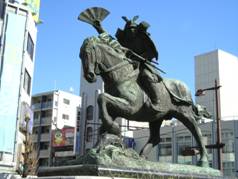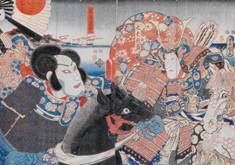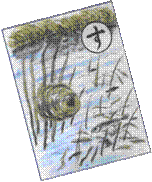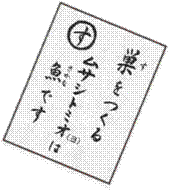|
3 Kumagai Naozane |
| Do you know Kumagai Naozane? He was called “The Strongest Samurai in Japan(日本一の剛の者)”. He was born in Kumagaya, Saitama. . |
 |
In 1184, he went to |
| When Naozane saw Atsumori’s face, he found that Atsumori was very young. Naozane felt very sorry for Atsumori because he was as young as his son. He didn’t want to kill Atsumori. But at that moment Naozane’s fellow samurai were watching so he could not help killing Atsumori. You can read this story in Heike Monogatari. |
 |
|
|
At the age of 53, Naozane retired from samurai
life and became a Buddhist priest. He wanted to console people who had
been killed. He had felt very sorry about
Atsumori for a long time. He studied Buddhism very hard. He came back to
his dear old hometown, Kumagaya when he was 66 years old. There is an
interesting story known as “Sakasa Uma”. When he left The Strongest Samurai ended his 67 years of life as a Buddhist priest in Kumagaya at the beginning of the 13th century. Now Naozane’s story still lives in Kabuki and Ukiyoe. You can also see the statue of Naozane in front of Kumagaya station. (245語) . |
|
Minamoto
Yoshitsune 源義経
Taira
Atsumori
平敦盛 defeat
打ち負かす The Battle in Ichino-tani 一ノ谷の合戦 engage in single combat 一騎打ちで戦う fellow samurai 家来 Buddhism
仏教
become
a Buddhist priest 出家する
console
慰める
had
been killed
それまでに殺された
had
felt ずっと感じていた
Sakasa
Uma 逆さ馬
backwards
後ろ向きに turn
one’s back to〜
〜に背を向ける
|
![]()
|
アメリカからの留学生マイク(Mike)は武藤先生の家にホームステイしています。 ある日マイクは部屋で何かを見つけ、武藤先生にたずねています。 |
||
| Mike: | Ms. Muto. What are these cards? |  |
| Ms. Muto: | Oh, they’re a game called Karuta. | |
| Each card has a picture of special place or thing from Kumagaya. | ||
| Mike: | That sounds interesting. | |
| Ms. Muto: | My children practice reading with them. Take a card and try to read it. | |
| Mike: | OK. “Su wo tsukuru musashitomio wa sakana desu.” | |
| Ms. Muto: | Now look for the picture with the character “su” on it. | |
| Mike: | OK… Here it is! | |
| Ms. Muto: | Do you understand the meaning? |  |
| Mike: | I think so. The fish in the picture make their own nests. | |
| Ms. Muto: | That’s right! They’re a natural treasure. | |
| Mike: | Oh, really? | |
| You can learn a lot about Kumagaya from these cards, can’t you? | ||
| Ms. Muto: | Yes, you can. We also have cards about Kumagai Naozane. | |
| Mike: | Who’s that? | |
| Ms. Muto: | He is called the strongest samurai in Japan. He was born in Kumagaya. | |
| You can see his statue in front of Kumagaya station. | ||
| Mike: | Oh yes! I’ve seen that statue! Those cards sound really interesting too. | |
| Can I borrow the cards about Kamagai Naozane first? | ||
| Ms. Muto: | Sure. | |
| Mike: | Thank you. I really want to learn about Samurai. | |
| Ms. Muto: | Well, there are many kinds of Karuta cards so you can learn about many things. | |
| Mike: | Great! Ms. Muto, I just had an idea! | |
| Ms. Muto: | What is it? | |
| Mike: | When I leave Japan, I want to give a goodbye present to your children. | |
| So,
I’d like to make them some Karuta cards about my hometown in the |
||
| Ms. Muto: | That’s a great idea, Mike! They will be very excited. | |
| Mike: | I will draw the pictures. Can you help me write the Japanese? | |
| Ms. Muto: | Of course, I can. | |
| Mike: | Thank you. Well, I should start making the cards now. I have a lot of work to do! | |
|
nest
巣 nature treasure
天然記念物 |